2018 has seen several significant changes and improvements in how healthcare is administered, from advances in personalised medicine to the development of new wearable technologies. Today, we have smart inhalers, artificial pancreas and teletherapy procedures that have helped improve patient access, lower wait times, costs and much more.
However, all these impressive advancements are ineffective without proper technological infrastructure— such as carrier grade wireless LAN— and legacy WiFi networks will inhibit their full potential. Superior wireless LAN is the key ingredient to supporting the following healthcare advancements in and out of facilities as they all require reliable connectivity to function at their peak.
- Advanced patient monitoring
Big data and centralised monitoring, supported by effective wireless LAN, play key roles in the healthcare field. One of the areas that it is contributing is throughout intensive care units (ICU) where these systems provide timely and accurate data when it comes to crises situations, especially in terms of alarm and alert systems.
80 per cent of hospital alarms that are often sounded were deemed unnecessary, according to a study by Cleveland Clinic physicians and scientists. This kind of excessive alerting system and noise can lead to alarm fatigue and cost people lives and adequate treatment.
Employing advanced monitoring equipment, such as cameras and sensors, centralised monitoring stations that can spot and analyse patient trends filter out any unimportant alarm and focus on delivering onsite intervention at the right time.
- Wireless tech in devices
Incorporations of wireless technology into bedside and medical devices will vastly improve the mobility, flexibility and accessibility for patients and staff alike. Eliminating unnecessary cables and wires means patients and devices are able to be remotely programmed and monitored, alleviating the burden on onsite resources.
Streaming data from medical equipment, direct to mobile devices or workstations, will also allow more efficient healthcare systems whilst streamlining internal processes. This kind of wireless technology that 2018 is starting to see more of, means that real time data is available and medical staff can access it directly, even when not at the healthcare facility and when the patient has returned home.
Additionally, it has the incidental benefit of keeping track of expensive equipment, minimising loss and damage costs, which Frost & Sullivan for GE Healthcare claim to be costing Australian hospitals more than sixty million dollars a year.
- Global patient engagement solutions
Engagement tools improve communication which leads to faster consultation time and reduced costs as well as effective diagnoses and treatment and decreases the burden on staff. They also pave the way for a better patient experience plus make it more manageable to achieve the health goals of the patient.
The use of online personal health records and patient portals also provides numerous benefits by compelling people to take initiative for their own health and expanding their medical knowledgeable base, further easing the burden on the industry.
‘Analytics could help by presenting to both the patient… and the caregiver the most important, actionable items to accomplish an individual’s health goals,’ says Healthcare Dive.
- Artificial pancreas
According to Diabetes Australia, diabetes is responsible for more Australian deaths every year than breast cancer and AIDS combined. Now, more than 1.7 million Australians living with diabetes have something to hope for: a hybrid closed loop bio artificial pancreas that is hailed as the world’s first artificial pancreas.
The artificial pancreas features a continuous glucose monitoring device and insulin delivery system that uses an algorithm which makes Type 1 diabetes and blood sugar levels more manageable. The artificial pancreas uses a closed wireless LAN, so diabetic patients don’t have to rely on information from their continuous glucose monitor to determine how much insulin to inject.
- Remarkable reduction in LDL cholesterol
Low density lipoprotein (LDL), also known as bad cholesterol, is the primary cause of fatty deposits that clog arteries and cause major heart diseases. According to The Heart Foundation, nearly 33 per cent of Australians lives with abnormally high LDL cholesterol levels. Thankfully, new drug formulations have been developed to reduce these levels by as much as 75 per cent.
Patients who take special cholesterol lowering PCSK9 inhibitors combined with statins are said to be able to reduce their LDL levels drastically.
- The emergence of telehealth
According to the Center for Connected Health Policy, telehealth is a method for enhancing healthcare delivery and support via distance using advanced telecommunication technologies. Telehealth is particularly important for those who live in regional, rural and remote areas of Australia and is also beneficial for specialised populations such as senior Australians.
A notable advancement in telehealth is enterprise imaging, which involves a high quality image that is useful for providing a fast and more accurate diagnosis by a specialist offsite. The reporting and data storage will then mean the patient and relevant healthcare professionals will be able to access the information from anywhere in the world.
Healthcare professionals are now able to monitor vital signs, such as heart rate or blood pressure from long distances using mobile technology. It is believed that about 90 per cent of healthcare services are getting ready for widespread telehealth adoption in 2018.
Associated telehealth and individual health applications, make use of artificial intelligence algorithms and wireless LAN to monitor patients and alert specialists, doctors and other healthcare professionals.
You can see that without the right technology wireless LAN systems in place, all these advancements are not able to run efficiently and effectively.











